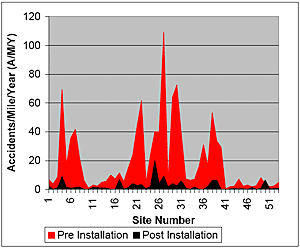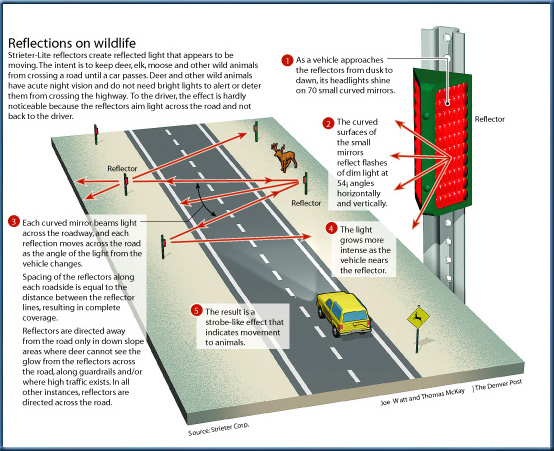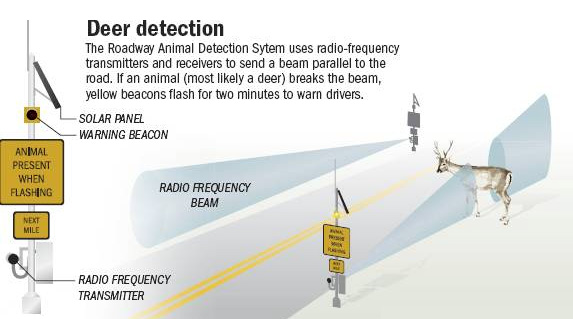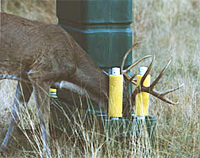| |
Cayuga Heights Mayor Jim Gilmore, Deputy Mayor David Donner, and Deer Remediation Advisory Committee (DRAC) Chairperson Kate Supron have emphasized that they believe deer need to be killed for reasons of public safety.1 As documented elsewhere on this site, there are serious questions about the quality of information and reasoning used by DRAC to evaluate these potential risks, not to mention the safety and ethics of their preferred approach.
In every case there is a safer, more ethical, and more sensible approach than a program centered on annually baiting and shooting deer in the midst of our densely settled suburban community.
Deer-vehicle collisions
In 2006, 2007 and 2008, there were, respectively, 11, 12 and 3 (as of 9/30/08) deer-vehicle collisions in Cayuga Heights.5 None of these accidents resulted in serious human injury. This reflects a state-wide trend, where only a small percentage of deer-vehicle collisions result in serious human injury,6 a trend that is likely accentuated by Cayuga Heights' relatively low speed limit. In fact, most fatalities from deer-vehicle collisions happen in speed zones of 55 mph or higher, when the victims are not wearing seatbelts or motorcycle helmets.7 It is interesting to note that a report by the Department of Natural Resources at Cornell University in 2001 found that the rate of deer-vehicle collisions in Cayuga Heights had been approximately 10 per year for the previous six years.8 Hence, the idea that the deer population in Cayuga Heights is spiralling out of control, and bringing with it a dramatic increase in deer-vehicle collisions, is not supported by the data.
Of course, no one wishes to experience a car accident of any sort. And even though the data suggests that the rate of deer-vehicle collisions in Cayuga Heights is relatively steady, if our community wishes to reduce the rate of deer-vehicle collisions, there are numerous safe, ethical, and rational alternatives.
 For example, there are roadside reflector technologies such as the Streiter-lite system, which uses reflected light from the headlights of oncoming cars to alert deer. This system has been installed in numerous locations around the world. Its effectiveness in reducing deer-vehicle collisions has been studied, showing results of 78-90% (see graph at right which shows accident rates before and after installation of reflectors).9 For example, there are roadside reflector technologies such as the Streiter-lite system, which uses reflected light from the headlights of oncoming cars to alert deer. This system has been installed in numerous locations around the world. Its effectiveness in reducing deer-vehicle collisions has been studied, showing results of 78-90% (see graph at right which shows accident rates before and after installation of reflectors).9
There is a Strieter-lite system installation in Owego, New York, just 30 miles South of Ithaca. According to the Owego traffic engineer, the reduction of deer-vehicle collisions has been high, nearly 100%.10 The cost of installing this system may also be reduced by federal grant support.11

Another promising technology, the Roadside Animal Detection System (RADS), takes a different approach. RADS uses radio sensors to detect large animals approaching a roadway. If an animal gets too near a road, the sensor activates a warning signal, alerting drivers to be cautious and slow down. One study in Switzerland found that such animal detection systems produced a reduction in collisions of up to 82 percent.12

Fencing is another proven alternative which can be used on its own or in combination with the options shown above. According to several studies, wildlife fencing, if used correctly, has the documented potential to reduce deer-vehicle collsions dramatically. One study in Banff, Alberta, for example, showed that fencings systems reduced collisions by 80%.13
There is also data suggesting that vehicle speed is correlated with the rate of deer-vehicle collisions, so more strict enforcement of the speed limit may be helpful. Community education programs that teach drivers how to drive more safely and avoid deer-vehicle collisions could further contribute to a reduction of collision risk.
Each of these alternatives to a bait and shoot program offers a documented potential to significantly reduce the risk of deer-vehicle collsions, and without negative side-effects, including the safety risks associated with the annual discharge of weapons in a densely settled community. Mayor Gilmore has spoken at a public meeting of allocating initial funding of $50,000 to a deer killing program. And as outside experts who have spoken at meetings have confirmed, a bait and shoot program is not a one-time solution, but rather a yearly endeavor.14 Thus, the public safety risks, the cost to tax payers, and the moral weight of killing human-habituated deer would continue to accrue year after year.
We can do better. Resources invested in sensible, nonviolent alternatives are a far better investment as they will provide immediate results, and will continue to offer value to the community for years to come.
Disease
The DRAC has identified three potential disease risks associated with deer:
1. Chronic wasting disease (CWD)
CWD is a serious issue — for people who eat deer meat, and in states where the disease has a strong presence. However, New York is not one of those states. So far, only two cases of CWD have ever been found in New York's wild deer population.15 Hence, killing local deer out of a fear of CWD is simply irrational. However, for those who want to be extra safe, refraining from eating deer meat is surely the way to go.
2. Illness caused by contact with deer feces
 When contacted about this issue, a staff member of the Tompkins County Health department did not know of any record of residents who have become ill through contact with deer feces, and had never heard of this being a public health issue in general. That said, most mothers generally teach their children not to play with feces, regardless of the source, and to wash their hands should they come in contact with feces. Following this time tested rule seems more sensible than trying to reduce the aggregate amount of deer feces in our community by killing a large number of deer every year. After all, shall we contemplate eradicating the squirrels, birds, cats, dogs and other animals in our community in order to create a feces-free environment? When contacted about this issue, a staff member of the Tompkins County Health department did not know of any record of residents who have become ill through contact with deer feces, and had never heard of this being a public health issue in general. That said, most mothers generally teach their children not to play with feces, regardless of the source, and to wash their hands should they come in contact with feces. Following this time tested rule seems more sensible than trying to reduce the aggregate amount of deer feces in our community by killing a large number of deer every year. After all, shall we contemplate eradicating the squirrels, birds, cats, dogs and other animals in our community in order to create a feces-free environment?
3. Lyme Disease
With a rate of infection averaging 3.3 per 100,000 people, the incidence of Lyme Disease in Tompkins county is low compared to many other counties in New York state. For example, the state's average infection rate is 26.2 per 100,000, and some counties in the Hudson Valley and Long Island see hundreds of cases of Lyme Disease per 100,000 residents.16 Of the few cases of Lyme disease seen in Tompkins county, it is believed that at least some of the them were contracted by people while traveling to areas where the incidence of the disease is much higher.
However, regardless of the rate of infection, it's important to understand that people don’t catch Lyme disease from deer. It is ticks that transmit the disease to humans. If a person is bitten by an infected tick, and does not remove the tick within 36 hours, they may contract Lyme disease. One study indicated that the risk of infection from a recognized tick bite was 1 to 2 percent. If infection does occur, early and appropriate treatment almost always results in a prompt and uncomplicated cure.17
So, if our community is serious about lowering our already comparatively low rate of this disease, does it make sense to kill lots of deer? While it is true that deer and other large mammals play a part in the reproductive cycle of deer ticks, who feed on them before laying their eggs, most cases where killing deer has been shown to be effective in significantly reducing tick populations have been on islands and peninsulas where it was possible to carry the killing to the extent of near eradication.18
 The American Lyme Disease Foundation does not advocate for deer killing programs to control the spread of Lyme disease. Instead, they promote the use of a technology called the “4 Poster” that kills the mature ticks on deer. The 4 Poster method has been shown capable of reducing tick populations by 92-98% over three years.19 Another effective method is to use simple cardboard tube and box applicators that apply an agent that kills the immature ticks called nymphs that are feeding on field mouse hosts.20 Ticks at the nymph stage are the most common transmistters of Lyme disease to humans. These sorts of devices have been shown to reduce tick populations by a high percentage as well.21 The American Lyme Disease Foundation does not advocate for deer killing programs to control the spread of Lyme disease. Instead, they promote the use of a technology called the “4 Poster” that kills the mature ticks on deer. The 4 Poster method has been shown capable of reducing tick populations by 92-98% over three years.19 Another effective method is to use simple cardboard tube and box applicators that apply an agent that kills the immature ticks called nymphs that are feeding on field mouse hosts.20 Ticks at the nymph stage are the most common transmistters of Lyme disease to humans. These sorts of devices have been shown to reduce tick populations by a high percentage as well.21
Probably the simplest, most cost-effective, and safest method of reducing our already low rate of Lyme disease is education. If people know to dress properly before venturing into areas where ticks are known to be found, if they bathe after time spent in nature and then check themselves and their children for ticks, and if they know how to recognize the symptoms of Lyme disease, the risks can be substantially reduced. This can be accomplished by supporting the efforts of the Tompkins County Health Department to educate the people of our county as well as to offer more advanced training for area health care professionals in the diagnosis of the disease.
Deer-human aggression
Outside of situations where people are trying to capture, harm or kill deer or their young, aggression of wild deer toward humans is extremely rare. Instead of annually killing a large number of suburban deer in an attempt to lower the risk of an already extremely unlikely possibility, it simply makes sense to refrain from attempting to capture, harm or kill the deer or their young in the first place.
In conclusion
DRAC has made a case that deer should be killed for reasons of public safety. A common sense analysis of the specific concerns they raise demonstrates that in several cases, the risks are less significant than is being implied by several members of the DRAC, and that in every case, killing deer is not the best option for reasons of safety, effectiveness, and ethics. It is not possible to eliminate all risk from life, and since our time and financial resources are limited individually and as a community, it makes sense to carefully prioritize our risk reduction efforts. When, as in the case of a bait and shoot program, the solution introduces even more serious risks than the purported problem, isn’t it time to step back and think a little more about where we are going?
This web site is published by CayugaDeer.org - Ithacans for Safe, Ethical, and Rational Approaches to Reducing Deer-Human Conflict. We are a group of concerned citizens from Ithaca neighborhoods, including Cayuga Heights. If you would like to join our educational outreach effort and be informed of opportunities where your input can make a difference, contact us.
References:
|

